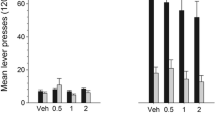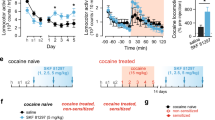Abstract
Rationale
Previous studies have found a role for dopamine D2-like receptors in many of the behavioral effects of cocaine, including its stimulation of locomotor activity and interoceptive discriminative-stimulus effects. However, given the lack of selectivity of most of the available pharmacological tools among D2, D3 and D4 dopamine receptors, the roles of these specific receptors remain unclear.
Objectives
The roles of specific dopamine D4 receptors in the behavioral effects of cocaine, including its locomotor stimulant and interoceptive discriminative-stimulus effects were investigated using dopamine D4 receptor knockout (DA D4R KO) and wild-type (WT) mice.
Methods
The mice were trained in daily sessions to discriminate IP injections of saline from cocaine (10 mg/kg). Responses on one of two response keys intermittently produced a food pellet; one response was reinforced in sessions following cocaine injection (10 mg/kg), and the other response was reinforced in sessions following saline injection. Each 20th response produced a food pellet (fixed-ratio, or FR20 schedule of reinforcement). The dose-effects of cocaine and its interaction with the D2-like antagonist, raclopride, were assessed. Horizontal locomotor activity was also assessed in each genotype.
Results
As previously shown), cocaine was a more potent stimulant of locomotor activity in the DA D4R KO mice compared to WT littermate mice. In addition, cocaine was more potent in producing discriminative-stimulus effects in DA D4R KO mice (ED50 value=0.50 mg/kg) compared to their WT littermates (ED50 value=2.6 mg/kg). Raclopride shifted the cocaine dose-effect curve in both DA D4R KO and WT mice, though the shift was greater for the DA D4R KO mice.
Conclusions
The present results on the stimulation of activity and interoceptive/subjective effects of cocaine are consistent with the previously reported disregulation of dopamine synthesis in DA D4R KO mice, and further suggest a role of the DA D4R in vulnerability to stimulant abuse.



Similar content being viewed by others
References
Ariano MA, Wang J, Noblett KL, Larson ER, Sibley DR (1977) Cellular distribution of the rat D4 dopamine receptor protein in the CNS using anti-receptor antisera. Brain Res 752:26–34
Benjamin J, Li L, Patterson C, Greenberg BD, Murphy DL, Hamer DH (1996) Population and familial association between the D4 dopamine receptor gene and measures of novelty seeking. Nat Genet 12:81–84
Caine SB, Negus SS, Mello NK, Patel S, Bristow L, Kulagowski J, Vallone D, Saiardi A, Borrelli E (2002) Role of dopamine D2-like receptors in cocaine self-administration: studies with D2 receptor mutant mice and novel D2 receptor antagonists. J Neurosci 22:2977–2988
Chausmer AL, Katz JL (2001) The role of D2-like dopamine receptors in the locomotor stimulant effects of cocaine in mice. Psychopharmacology 155:69–77
Chausmer AL, Elmer GI, Rubinstein M, Low MJ, Grandy DK, Katz JL (2002) Cocaine-induced locomotor activity and cocaine discrimination in dopamine D2 receptor mutant mice. Psychopharmacology 163:54–61
Comings DE, Gonzalez N, Wu S, Gade R, Muhleman D, Saucie G, Johnson P, Verde R, Rosenthal RJ, Lesieur HR, Rugle LJ, Miller WB, MacMurray JP (1999) Studies of the 48 bp repeat polymorphism of the DRD4 gene in impulsive, compulsive, addictive behaviors: Tourette syndrome, ADHD, pathological gambling, and substance abuse. Am J Med Genet [Neuropsychiatr Genet] 88:358–368
Costanza RM, Terry P (1998) The dopamine D4 receptor antagonist L-745,870: effects in rats discriminating cocaine from saline. Eur J Pharmacol 345:129-132
D'Mello G, Stolerman IP (1977) Cocaine and amphetamine as discriminative stimuli in rats. Br J Pharmacol 59:453P-454P
Defagot MC, Falzone TL, Low MJ, Grandy DK, Rubinstein M, Antonelli MC (2000) Quantitative analysis of the dopamine D4 receptor in the mouse brain. J Neurosci Res 59:202–208
Dews PB (1953) The measurement of the influence of drugs on voluntary activity in mice. Br J Pharmacol 8:46-48
Dulawa SC, Grandy DK, Low MJ, Paulus MP, Geyer MA (1999) Dopamine D4 receptor-knock-out mice exhibit reduced exploration of novel stimuli. J Neurosci 19:9550-9556
Falzone TL, Gelman DM, Young JI, Grandy DK, Low MJ, Rubinstein M (2002) Absence of dopamine D4 receptors results in enhanced reactivity to unconditioned, but not conditioned, fear. Eur J Neurosci 15:158–164
Finney DJ (1964) Statistical methods in biological assay, 2nd edn. Hafner, New York
George SR, Cheng R, Nguyen T, Israel Y, O'Dawd BF (1993) Polymorphisms of the D4 dopamine receptor alleles in chronic alcoholism. Biochem Biophys Res Commun 196:107–114
Izenwasser S, Terry P, Heller B, Witkin JM, Katz JL (1994) Differential relationships among dopamine transporter affinities and stimulant potencies of various uptake inhibitors. Eur J Pharmacol 263:277-283
Kelly PH, Iversen SD (1976) Selective 60HDA-induced destruction of mesolimbic dopamine neurons: abolition of psychostimulant-induced locomotor activity in rats. Eur J Pharmacol 40:45-56
Kotler M, Cohen H, Segman R, Gritsenko I, Nemanov L, Lerer B, Kramer I, Zer-Zion M, Kletz I, Ebstein RP (1997) Excess dopamine D4 receptor (D4DR) exon III seven repeat allele in opioid-dependent subjects. Mol Psychiatry 2:251–254
Kruzich PJ, Suchland KL, Grandy DK (2002) Dopamine D4 receptor deficient mice show enhanced sensitivity to amphetamine-stimulated locomotor activity. Program No. 400.5. 2002 Abstract Viewer/Itinerary Planner. Society for Neuroscience, Washington D.C., CD-ROM
Millan MJ, Newman-Tancredi A., Brocco M, Gobert A, Lejeune F, Audinot V, Rivet JM, Schreiber R, Dekeyne A, Spedding M, Nicolas JP, Peglion JL (1998) S 18126 ([2-[4-(2,3-dihydrobenzo[1,4]dioxin-6-yl)piperazin-1-yl methyl]indan-2-yl]), a potent, selective and competitive antagonist at dopamine D4 receptors: an in vitro and in vivo comparison with L 745,870 (3-(4-[4-chlorophenyl]piperazin-1-yl)methyl-1H-pyrrolo[2,3b]pyridine) and raclopride. J Pharmacol Exp Ther 287:167–186
Rubinstein M, Phillips TJ, Bunzow JR, Falzone TL, Dziewczapolski G, Zhang G, Fang Y, Larson JL, McDougall JA, Chester JA, Saez C, Pugsley TA, Gershanik O, Low MJ, Grandy DK (1997) Mice lacking dopamine D4 receptors are supersensitive to ethanol, cocaine, and methamphetamine. Cell 90:991-1001
Snedecor GW, Cochran WG (1967) Statistical methods, 6th edn. State University Press, Ames, Iowa
Suchland KL, Harrison L, Pasumamula S, Kruzich PJ, Rubinstein M, Low MJ, Grandy DK (2002) Mice lacking dopamine D4 receptors display supersensitivity to methylphenidate-stimulated locomotor activity. Program No. 103.1. 2002 Abstract Viewer/Itinerary Planner. Society for Neuroscience, Washington D.C., SCD-ROM
Vandenbergh DJ, Zonderman AB, Wang J, Uhl GR, Costa PT Jr (1997) No association between novelty seeking and dopamine D4 receptor (D4DR) exon III seven repeat alleles in Baltimore Longitudinal Study of Aging participants. Mol Psychiatr 2:417–419
Woolverton WL, Trost RC (1978) Cocaine as a discriminative stimulus for responding maintained by food in squirrel monkeys. Pharmacol Biochem Behav 8:627-630
Acknowledgements
We thank Dawn French and Patty Ballerstadt for excellent technical work and administrative support, respectively. Some of the research reported herein was supported by a grant from the National Institute on Drug Abuse DA12062 (D.K. Grandy, PI), as well as funding by the National Institute on Drug Abuse Intramural Research Program (J.L. Katz, PI). We thank Barry Hoffer for his support. Portions of this paper were presented at the Dopamine 2002 Satellite meeting of the IUPHAR in Portland Oregon, July 10–14, 2002.
Author information
Authors and Affiliations
Corresponding author
Rights and permissions
About this article
Cite this article
Katz, J.L., Chausmer, A.L., Elmer, G.I. et al. Cocaine-induced locomotor activity and cocaine discrimination in dopamine D4 receptor mutant mice. Psychopharmacology 170, 108–114 (2003). https://doi.org/10.1007/s00213-003-1513-z
Received:
Accepted:
Published:
Issue Date:
DOI: https://doi.org/10.1007/s00213-003-1513-z




